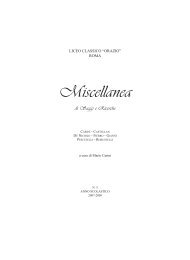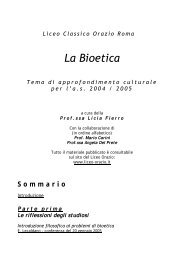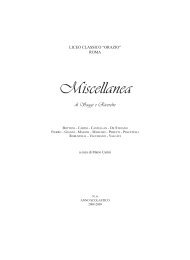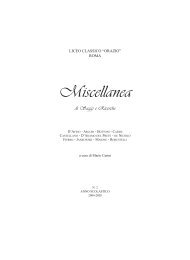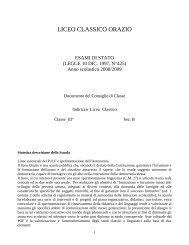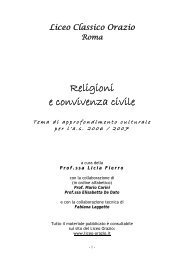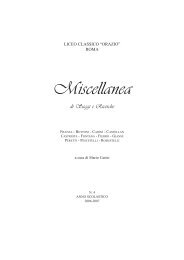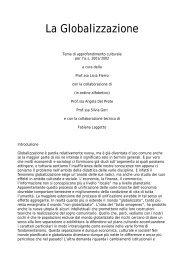- Page 1 and 2:
LICEO CLASSICO “ORAZIO” ROMA Mi
- Page 3 and 4:
INDICE Introduzione . . . . . . . .
- Page 5 and 6:
INTRODUZIONE Il terzo volume della
- Page 7:
sinistra alla stesura della Costitu
- Page 11 and 12:
ANNA PAOLA BOTTONI - GREGORIO FRANZ
- Page 13 and 14:
Il regolamento, infatti, non è cos
- Page 15 and 16:
La redazione del regolamento è un
- Page 17 and 18:
studenti, inoltre, percependo la re
- Page 19 and 20:
mai avuto buona fama almeno nell’
- Page 21 and 22:
2. la riparazione del danno non est
- Page 23 and 24:
apparvero: «Le peregrinazioni del
- Page 25 and 26:
acconto dei personaggi a lui cari l
- Page 27 and 28:
L’idea del progresso era strettam
- Page 29 and 30:
1. Il conservatorismo di Scott è p
- Page 31 and 32:
Il merito di W. Scott consisterebbe
- Page 33 and 34:
in quanto essi assolvono a una funz
- Page 35 and 36:
GIUSEPPE D’AVINO Il romanzo elegi
- Page 37 and 38:
“Del neorealismo coevo Cassola ac
- Page 39 and 40:
l’aver scoperto la eterna presenz
- Page 41 and 42:
sua attenzione su quegli aspetti de
- Page 43 and 44:
Baba (1946), Esiliati (1953), La ca
- Page 45 and 46:
Scritto 7 nel 1949 e pubblicato nel
- Page 47 and 48:
Man mano che il velo del tempo cala
- Page 49 and 50:
Non è solo questo, Anna riesce rea
- Page 51 and 52:
superstizione, tradizioni locali e
- Page 53 and 54:
GIUSEPPE D’AVINO Il regno di Natu
- Page 55 and 56:
E il ministro riportò al re le par
- Page 57 and 58:
Il bambino intanto aveva preso per
- Page 59 and 60:
queste notizie non le dava e sono r
- Page 61 and 62:
Ovunque e per tutti c’era lei, la
- Page 63 and 64:
ANNA PAOLA BOTTONI Alcune riflessio
- Page 65 and 66:
si esplica la didattica orientativa
- Page 67 and 68:
3. sostiene le capacità di individ
- Page 69 and 70:
quindi, salvaguardare i nuclei cono
- Page 71 and 72:
MARIO CARINI Uno strumento di appro
- Page 73 and 74:
ciò che ha visto effettivamente (N
- Page 75 and 76:
monianza orale, affinché si stabil
- Page 77 and 78:
di per sé la scelta di far svolger
- Page 79 and 80:
Nonno/a dell’alunno/a: Evento sto
- Page 81 and 82:
accontare sono sempre singoli indiv
- Page 83 and 84:
gravissime distruzioni soprattutto
- Page 85 and 86:
seconda, temporanea ma necessaria,
- Page 87 and 88:
la polemica svolta da parte fascist
- Page 89 and 90:
Mältzer, il quale pochi istanti pr
- Page 91 and 92:
isposte dei nonni il ricordo degli
- Page 93 and 94:
di via Nazionale. Il clima era per
- Page 95 and 96:
tedesco, per la precisione uno Junk
- Page 97 and 98:
nonna dell’alunna Marta (risposta
- Page 99 and 100:
7. Ricordi della seconda guerra mon
- Page 101 and 102:
sbarco di Anzio Nettuno fu presa e
- Page 103 and 104:
Concludo con un ricordo personale:
- Page 105 and 106:
____ ____ ____ Per chiarire il conc
- Page 107 and 108:
che potrebbero cambiare le caratter
- Page 109 and 110:
valore estetico che si possa esprim
- Page 111 and 112:
Dal momento che il film, soprattutt
- Page 113 and 114:
sato sulla corrispondenza di Welles
- Page 115 and 116:
1. Ogni stampa è un oggetto unico,
- Page 117 and 118:
ANNA MARIA ROBUSTELLI Le sorelle di
- Page 119 and 120:
Nel percorso dell’anno passato, n
- Page 121 and 122:
The woman isn’t satisfied, becaus
- Page 123 and 124:
V. Woolf ci fa notare, inoltre, che
- Page 125 and 126:
Questi, infine, sono i primi versi
- Page 127 and 128:
soldi che le erano necessari scrive
- Page 129 and 130:
Concludendo il profilo biografico d
- Page 131 and 132:
When the intrepid Lady Mary Montagu
- Page 133 and 134:
Be banish’d afar both discretion
- Page 135:
Questa potenziale “sorella di Sha
- Page 139 and 140:
LICIA FIERRO Introduzione al lavoro
- Page 141 and 142:
personaggio di “riferimento” è
- Page 143 and 144:
1913-1914 (IV Governo Giolitti) e S
- Page 145 and 146:
A norma delle disposizioni finali e
- Page 147 and 148:
misuravano ormai in centinaia di mi
- Page 149 and 150:
Il PLI non ha mai ricoperto una fun
- Page 151 and 152:
Stati americani indipendenti e i pr
- Page 153 and 154:
volta alla sua patria quindi è com
- Page 155 and 156:
Concilio stesso. Dopo di ciò decis
- Page 157 and 158:
La Costituzione Europea però nasce
- Page 159 and 160:
sul dato del lavoro, non su chi viv
- Page 161 and 162:
indiscutibilmente va verso il megli
- Page 163 and 164:
conda parte della Costituzione inti
- Page 165 and 166:
Presidente della Repubblica. Nella
- Page 167 and 168:
prima parte, quella della premessa
- Page 169 and 170:
ito (bandite dalla comunità intern
- Page 171 and 172:
Guantanamo. Quindi, voglio dire, c
- Page 173 and 174:
vole Boato, da Berlusconi e da tant
- Page 175 and 176:
uomo di Nietzsche e ci sono i miser
- Page 177 and 178:
P. GINSBORG, Storia d’Italia 1943
- Page 179 and 180:
l’esercito nazista, che aveva inv
- Page 181 and 182:
poiché, dopo che già la Russia so
- Page 183 and 184:
CAPITOLO I L’ASSEMBLEA COSTITUENT
- Page 185 and 186:
mente dovevano spaziare su materie
- Page 187 and 188:
patto costituzionale: “un mutamen
- Page 189 and 190:
attività, l’implementazione di p
- Page 191 and 192:
di stampa soppressi. Ma il PCI fu l
- Page 193 and 194:
dall’unificazione italiana, nel m
- Page 195 and 196:
popolari, dalle lotte intestine. In
- Page 197 and 198:
) L’opera di Ruini, i lavori prep
- Page 199 and 200:
quella, presa in prestito dalla cos
- Page 201 and 202:
soppressa dal Comitato stesso che p
- Page 203 and 204:
nella Costituzione: all’apparenza
- Page 205 and 206:
anensi. Le modificazioni dei Patti
- Page 207 and 208:
senso potestativo, dicendosi tuttav
- Page 209 and 210:
primo, un istituto già esistente i
- Page 211 and 212:
cetto di legislatura che era comune
- Page 213 and 214:
A questa obiezione ribatté Lelio B
- Page 215 and 216:
consigli veniva espressamente riser
- Page 217 and 218:
comunque basilare concepire un pote
- Page 219 and 220:
dell’Assemblea, quando Mortati ri
- Page 221 and 222:
dei socialisti, una politica unitar
- Page 223 and 224:
MEUCCIO RUINI: nacque a Reggio Emil
- Page 225 and 226:
gi. Durante il ventennio fascista f
- Page 227 and 228:
“Chi eravamo? Chi rappresentavamo
- Page 229 and 230:
facendo riferimento ai principi del
- Page 231 and 232:
a deteriorarsi: non è il leader co
- Page 233 and 234:
I Patti Lateranensi Stipulati l’1
- Page 235 and 236:
Vero merito di Mussolini fu quello
- Page 237 and 238:
in quest’aula. Qui si tocca il fo
- Page 239 and 240:
Questo infatti ritenevamo fosse nec
- Page 241 and 242:
questa occasione non è stata guida
- Page 243 and 244:
Poi le cose cambiarono, senza dubbi
- Page 245 and 246:
zata l’unità morale e politica d
- Page 247 and 248:
Però noi vedemmo, già prima dell
- Page 249 and 250:
ARTICOLO 7 Lo Stato e la Chiesa cat
- Page 251 and 252:
Non crediamo sia stato mai proficuo
- Page 253 and 254:
che scoppia sotto il reazionario go
- Page 255 and 256:
L’affermarsi del Neoidealismo piu
- Page 257 and 258:
Sottolinea Giannantoni che il fasci
- Page 259 and 260:
Certo, si potrà dire che il libera
- Page 261 and 262:
venta) “l’idea è lì senza pen
- Page 263 and 264:
Bibliografia: N. ABBAGNANO e G. FOR
- Page 265 and 266:
Con Elena Croce collabora alla reda
- Page 267 and 268:
sofi quanto nei più quotidiani att
- Page 269 and 270:
stremo, convertito in assoluto. Tut
- Page 271 and 272:
Quello di Maria Zambrano può ben e
- Page 273 and 274:
naggi che si muovono al suo interno
- Page 275 and 276:
Per “democrazia” si intende que
- Page 277 and 278:
degger, con cui la Arendt instaurer
- Page 279 and 280:
La teoria portante è la concezione
- Page 281 and 282: ad allora considerate complementari
- Page 283 and 284: era un normale funzionario, ordinar
- Page 285 and 286: Il pensiero nasce dallo stupore: es
- Page 287 and 288: Agli inizi degli anni ’30, entra
- Page 289 and 290: nel “sostrato dei reietti e degli
- Page 291 and 292: la filosofia lascia tutto come lo t
- Page 293 and 294: Il malessere prorompente nella soci
- Page 295 and 296: spontanea di queste coraggiose donn
- Page 297 and 298: si sarebbe attenuato solo negli ann
- Page 299 and 300: stato assegnato dal maschio autorit
- Page 301 and 302: mane: “Il 5 Giugno viene processa
- Page 303 and 304: Dopo il referendum del ’46, la ve
- Page 305 and 306: Paesi 1987 1994 oggi Confronti Aust
- Page 307 and 308: MARIA PAOLA MAIONE Progetto special
- Page 309 and 310: FASE DEL PROGETTO 2004-2005 ADOZION
- Page 311 and 312: tratta di un saggio redatto grazie
- Page 313 and 314: DEGENERAZIONE DELLE TERME Già a pa
- Page 315 and 316: Edifici separati per uomini e donne
- Page 317 and 318: modo che i bagnanti potessero seder
- Page 319 and 320: Inizi del XVI sec. - Giuliano da Sa
- Page 321 and 322: I pannelli sono sostanzialmente lis
- Page 323 and 324: LA BASILICA DI SANTA MARIA DEGLI AN
- Page 325 and 326: Narcissus Quagliata, allievo di De
- Page 327 and 328: Sulla piazza dell’ex esedra reali
- Page 329 and 330: In questa zona di destra della Basi
- Page 331: il ministro maggior della natura, c
- Page 335 and 336: 1. ogni affermazione (anche la più
- Page 337 and 338: e questo non è possibile perché i
- Page 339 and 340: Definizione 2 Una coppia di primi g
- Page 341 and 342: Definizione Due espressioni lettera
- Page 343 and 344: 2° passo: proviamo che a = d per i
- Page 345 and 346: VALENTINA PELLEGRINI - CONSIGLIO DI
- Page 347 and 348: Docente n. 1: Certo, il disagio fam
- Page 349 and 350: Docente n. 5: Penso ci sia bisogno
- Page 351 and 352: 4) Questi comportamenti, secondo vo
- Page 353 and 354: 4) Ritenete giusto che questi ragaz
- Page 355 and 356: CLAUDIO JANKOWSKI Laboratorio teatr
- Page 357 and 358: Marion: Giulietta Dict: Romeo Nadin
- Page 359 and 360: Muore Piramo, entra Flute nel ruolo
- Page 361 and 362: AMLETO: Dov’è successo? ORAZIO:
- Page 363 and 364: ATTO II - SCENA II QUINCE: Bravi ra
- Page 365 and 366: OFELIA: Sei molto bravo a fare la p
- Page 367 and 368: OFELIA: Lo riveste candida coltre,
- Page 369 and 370: AMLETO: Rimango fedele ai miei prop
- Page 371 and 372: Colpisce il re con la spada. RE: O
- Page 373 and 374: GIULIETTA: Ma io riconosco la tua v
- Page 375 and 376: ROMEO: Ed io continuerò a restare
- Page 377 and 378: CATERINA: Uno sgabello. PETRUCCIO:
- Page 379 and 380: FRANCESCA RUBINI - CLASSE III L L
- Page 381 and 382: “Ognuno voltò la faccia in uno s



